From trash to treasure: The Nigerians recycling waste into wealth
As the world struggles to manage its waste, residents of Ibadan present alternative ways to recycle.
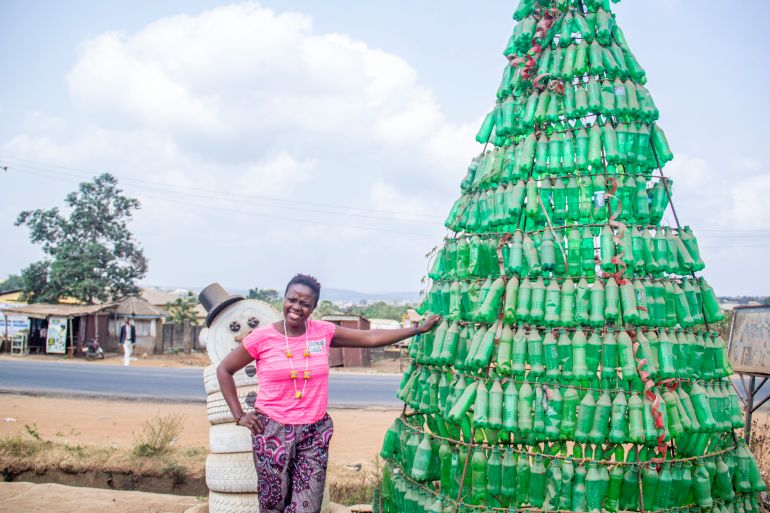
If you peer into the gutters of any big Nigerian city, a filthy sight awaits you: Floating cans, nylon water sachets, empty bottles and other waste materials discarded by humans, swept there by rain, gathering and clogging up the drain.
This is not only a Nigerian problem, it is a global challenge. The world continues to writhe under the burden of waste management. In 2019, the Global Material Footprint (the amount of raw material including fossil fuels, biomass and metal and non-metal ore, extracted to meet total consumption demand), according to the United Nations, was 85.9 billion tonnes – up from 73.2 billion tonnes 10 years before. Meanwhile, the world’s electronics waste – namely discarded smartphones, tablets and other electronic devices – grew by 38 percent in that same year.
Keep reading
list of 4 itemsPlastic recycling: Australian engineers create a ‘micro’ solution
Landfill Harmonic: Paraguay’s Recycled Orchestra
Refreshing: Coca-Cola introduces 100% recycled bottles in the US
Today, March 18, the world celebrates Global Recycling Day with the theme #RecyclingHeroes to draw attention to “the people, places and activities that showcase what an important role recycling plays in contributing to an environmentally stable planet and a greener future which will benefit all”.
In Nigeria, “wastepreneurs” are providing an answer to this by taking waste straight from the dump, transforming it and redefining its purpose. These innovators work with different materials – water sachets, scrap metal, bottles, plastic, tyres and more – with many of them learning on the job, how to manipulate these objects, to make “beauty out of ashes”. These entrepreneurs ask: “If you can recycle it, why waste it?”
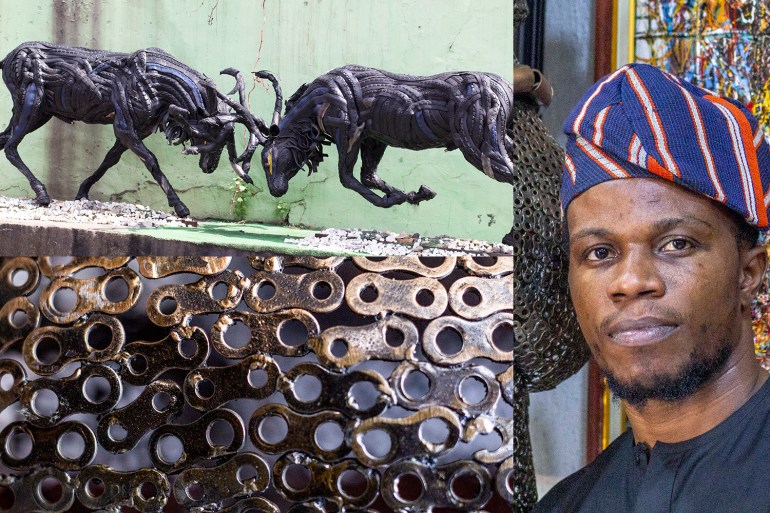
Ade Dagunduro: ‘Not trash, but a thing of beauty’
Surrounded by art pieces in his gallery in Dugbe at the heart of Ibadan, Ade Dagunduro, 34, takes us through his creative journey. A graduate of Fine Art from Obafemi Awolowo University, Ile-Ife, his desire to push the boundaries of what he learned within the walls of a university spurred him to take up more training in painting and sculpture.
“School was more theoretical, less practical. When you get out of school and into the real world, you realise there is much more to learn,” he says.
Art has “changed his life”, he adds, and, now, he can help improve life a little for others by taking waste from the streets to make art.
Originally working with regular art materials such as paint, clay and wood, five years ago, Dagunduro decided to challenge himself by thinking beyond those.
“I wanted to see if I could actually think outside the box. I asked myself if I could be more creative,” he says. In his quest to do this, Dagunduro learned to manipulate waste materials like used tyres, which would otherwise be burned – a common cause of pollution in Nigeria.
His first work with waste in 2016 was an ox made out of a tyre, called The Challenge. These days, he also works with metal, ropes and plastic which he finds on the streets in his community. Sometimes, people bring materials to his studio.
“Our environment can now smile because we have people like us trying to ease off its burden by picking the waste off its shoulders. These days, you hardly find cartons, for instance, littering the streets. Humans are exhausting the forests. Now we need more paper, so we have to start recycling what we see on the street,” he says.
Dagunduro’s latest work, titled Torso, is a female form made from dismantled motorcycle chains – which he picked up from a motorcycle mechanic’s workshop – welded together.
“You first craft with clay, then you take the mould which has been constructed and cast it out with cement. After that, you allow it to dry and then ‘liberate’ it out of the clay. So now that it is out, the pattern is already printed on the mould, and you can begin welding the metal around it, which is done in batches. After that, you couple the metal pieces together.”
Dagunduro says this is then followed by cleaning and shining, to prevent rust and preserve the artwork.
The motorcycle chains that would have been thrown on a dump now stand as a sculpture, in the far-right corner of Ade Dag Art Gallery, waiting to be bought; “waiting to re-enter the world that discarded it, not as trash but as a thing of beauty,” he says.
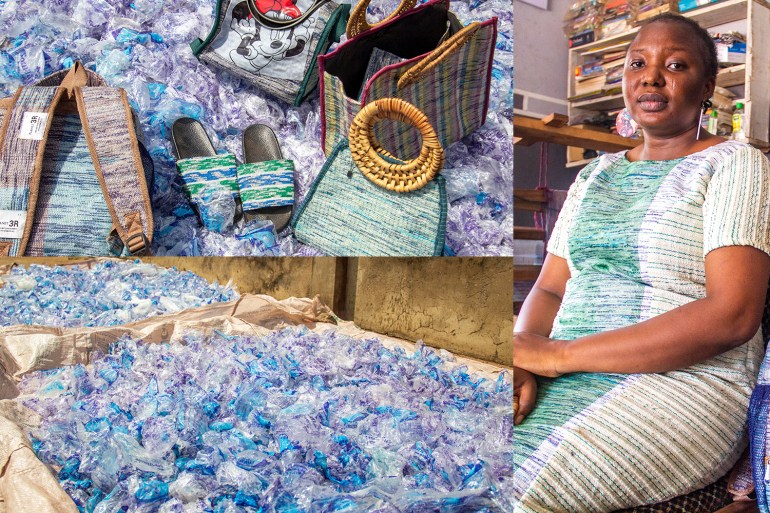
Adejoke Lasisi: Making a school bag from 250 used water sachets
Adejoke Lasisi, who is in her early 30s, is from a traditional, middle-class weaving family in Ibadan. Aged nine, she started weaving the popular aso-òfì, a material made from cotton threads, traditionally woven by Yorùbá people.
Now, she has turned her craft into a way to relieve her home city of some of its waste burden. In Nigeria, discarded “pure water” sachets – small, rectangular sachets of drinking water made from nylon – are a common sight on roads and in gutters.
“I began to pick them up,” she says. “I also began to think of what I could do with them.
“People were always complaining about the pure water nylon sachets everywhere. I worked out that it would be great to make these nylon sachets into colourful clothing.”
She has now perfected the art of blending weaving wool with nylon. Doing this involves a five-step process before the sachets are transformed into attractive products such as bags, purses, slippers, mats, artwork and more.
First, Lasisi sources the nylon – picking up sachets from the streets and receiving discarded, imperfect sachets from water processing plants. She says the nylon used to make pure water sachets has two advantages: It is the right texture for weaving and is largely a neutral colour, meaning it is easy to dye.
“After sorting, we wash the material thoroughly and disinfect it, after which we dry it in the sun. The whole process takes three days. Once dried, we shred the material with scissors into thread-like strands. Then, we can begin to weave them on the loom.”
One of her most popular products is a school bag which is made from 10 percent òfì and 90 percent nylon and recycles 250 water sachets in the process.
Since Lasisi started Planet3R, her for-profit business, in 2020, she has also partnered with different organisations and won several grants in Nigeria and overseas to train young people in the art.
“I hope that other young people will be able to save the environment with their hands too. The more wastepreneurs we have, the cleaner our environment becomes.”

Tunde Odunlade: ‘Fabrics tell stories’
On a table in Tunde Odunlade’s Bodija office stands a mound of different fabrics which have been thrown away. Close by, on the wall, a piece of art made from cotton fabric is mounted – showing, right here, the “before” and “after” process of his work.
Odunlade’s journey to wastepreneur took an unlikely route. After an exhibition of batik art in the United States in 1987, Odunlade, who is now in his 70s, had been told to come and pick up his exhibits to take them away for safekeeping but, because of his engagements, he could not find the time to do so.
Then, something unexpected happened. A cat owned by his friend at the gallery managed to get into the artworks and tore his batik to pieces.
“I was pained. I actually started crying but something told me that crying would not solve anything at that point. Instead, I should figure out a way to prevent future occurrence,” he says.
The solution he found marked the beginning of a new journey in his career as an artist.
“In order to prevent my work from tearing easily, I started layering, on top of one another, between four and six layers of used cloth in areas of importance in each work. That made it thicker,” says Odunlade.
Today, he collects used cloth which he likes to call “found material” as opposed to “waste material” because the materials are either found by him or, he says, the materials “find” him.
“Most of what people refer to as àkísà [the Yoruba word for rags], I now collect from people who otherwise would have thrown them away, in order to make a work of art,” says Odunlade, who calls this style of art batik quilt tapestry. These days, people bring cloth they no longer need to his studio.
Odunlade sees fabric as a means to document moments in our lives.
“You see, fabric in itself tells story … they all have documented history from time immemorial. Whatever fabric I use, it had a story before it got to me. After I make it into an artwork, it starts to tell another story as it speaks to people. So I see myself as a historian by virtue of working with these many fabrics,” he says.
For Odunlade, it is the responsibility of citizens to improve the environment. “The truth is that what we have done to the environment, that is what the environment is doing back to us.” He says the world is in this waste dilemma because of human actions and inactions.
“Sometimes when I am driving on the street or taking a public bus, I am always on the lookout for people who litter the environment. Once they do that, I charge towards them to challenge their dirty habit. Start from something as little as that,” he advises.
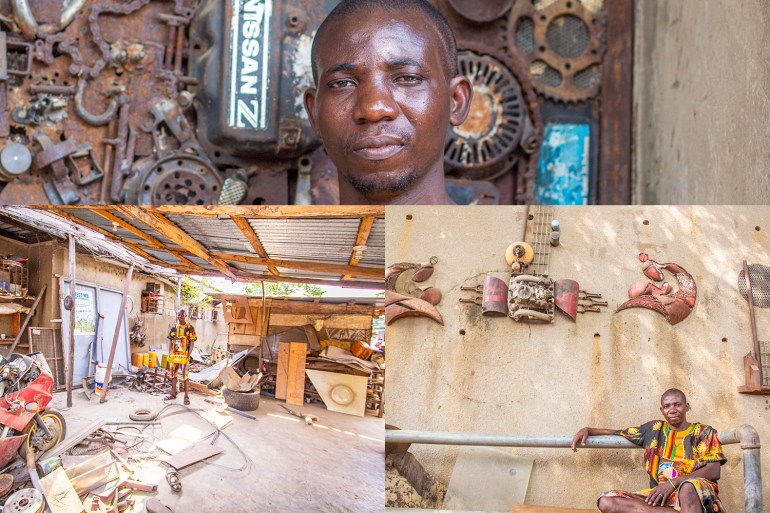
Wasiu Arowolo: ‘Nature had spoken to me’ – from tin cans to works of art
The son of a motor mechanic, Wasiu Arowolo had always been drawn to art. In his community in Ibadan, art was not viewed as a serious profession, but he pursued it anyway, gaining an apprenticeship at a popular gallery and studio called Topfat while other friends went off to college.
Arowolo says he could not always afford the tools and materials he needed to do the work – his family did not approve of his choice of study and did not support him. So he frequently found himself sitting under a tree, watching his fellow pupils at work outside.
One day, while he was waiting under the tree, a friend who was passing by suggested he “listen to nature”. “Look around you, there will be something to work with in nature,” the man said.
What Arowolo really started to notice, however, was how the rubbish and waste strewn around the streets was affecting the natural world. One day, in 2012, he found himself at a rubbish dump where he began picking up tin cans.
From these cans, he created a butterfly. He found this helped to relieve the anxiety he had been feeling about his job and about the environment around him. That was the beginning of his work as a waste artist.
“I was still trying to sort out one of the butterfly wings at my boss’s studio when a woman who was a customer at the gallery asked how much I was willing to sell it for, and she paid for it immediately.” This first payment – 25,000 naira ($65) gave him the boost he needed to continue with his craft.
Later that same year, he won the Life in My City art competition in Nigeria, winning 50,000 naira ($131). The theme of the competition was Being Young and he produced a waste-oriented project, titled Junior – a large pair of slippers made with cans, with a small child’s leg in it. For him, it symbolised the idea of young people trying to fit into their parents’ shoes, at an age when they are trying to make something of their lives.
These days, he uses metal in all of his artwork – mostly finding it on the streets – and has his own studio.
“I have lots of metal in my studio. Some pieces have been sitting there for eight years. I don’t draft in a sketch pad before coming up with ideas for my work. So, each of the metal items calls me by the day to say, ‘just use me’. I do what comes to my mind the moment I pick any of them up,” he says.
Nowadays, Arowolo’s work is highly sought-after. Far from the boy who could not afford tools to learn about art, he is now comfortably off.
“Seventy-five percent of my works are sold before completion. People pay ahead for my work. Go to some of the top-notch galleries in Ibadan; my works are there. So, I can tell you that acceptance of my work has been tremendous.”
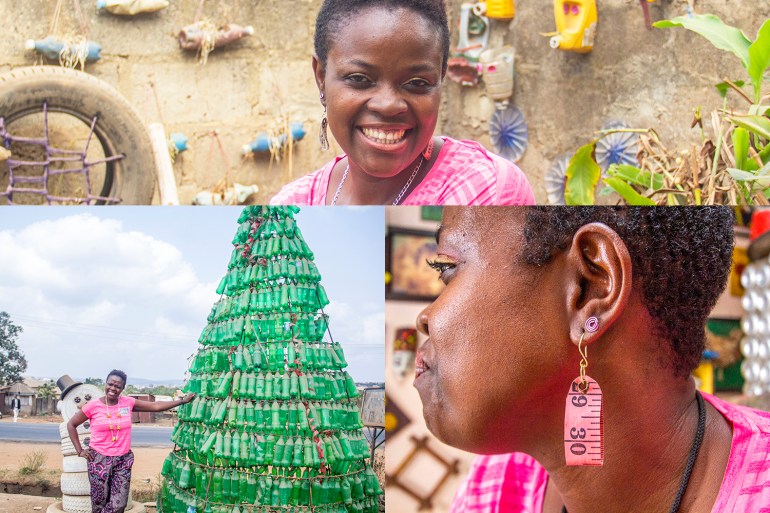
Jumoke Olowokere: Providing 40 schools with play equipment
When the manager of the five-apartment compound she lives in with her family informed the residents that their rubbish collection fee was going up because of the amount of waste they were generating, Jumoke Olowokere, 41, decided she had to take action. That was back in 2015.
“I started looking for things that should not be taken to the waste bin. Things that can be converted, things that can be reused.”
Today, she runs a small organisation that, among other things, converts waste into play equipment for schools.
In 2019, she celebrated her 40th birthday by gifting 40 schools in the city outdoor play equipment which was made with the help of the schools’ students. They used discarded tyres and ropes to make swings and climbing frames, decorating with bottle tops.
“My staff and I challenged the students to bring waste to school from their communities. With that, we built them playgrounds and we repainted the school walls outside. Many of them were painting with their hands, for the first time. In fact, some refused to wash their hands and went home with their coloured palms,” Olowookere says. The project was named PP40 (Perceptions Project 40) and it has benefitted some 20,000 students across Ibadan.
Olowokere’s business, Africa Creativity and Sustainability Hub, also has a shop that sells items such as ottoman chairs, sinks and garden ornaments made from old tyres, which she says are her favourite form of waste to work with.
When hand-washing became very important due to COVID-19, she made eight hand-washing basins stacked on tyres and installed them in different parts of the city.
“They are so solid, strong, rugged and dependable. Leave them for years, you will still find them, come sun come rain, they don’t break easily,” she says. Despite the durability of tyres, her biggest challenge while working with them has been the tools.
“As much as I love to work with them – because they are strong and rugged – it is difficult to manipulate them. There are so many ideas that I come up with but the tools have stopped me from realising them,” she laments. She hopes to find a way to make fences for residential compounds out of tyres.
The other challenge is acceptance.
“Some people don’t want to buy them because they are made from waste. People think you are crazy if you have tyres in your house. Little do they know that we need some level of madness to hand over a sustainable environment to the next generation.”
In December 2020, she made a snowman from tyres and a four-metre (13-foot) Christmas tree from 820 plastic bottles, which were placed on the road that leads to her office in Moniya, Ibadan. These are permanent fixtures that, she says, are a gentle reminder that “waste can be wealth”.
If they had not been made into these decorative pieces, the tyres would most likely have been burned in landfills, while the bottles would have ended up floating in gutters, washed around by rainwater.
Instead, today, recycled, they are adding beauty to the environment.
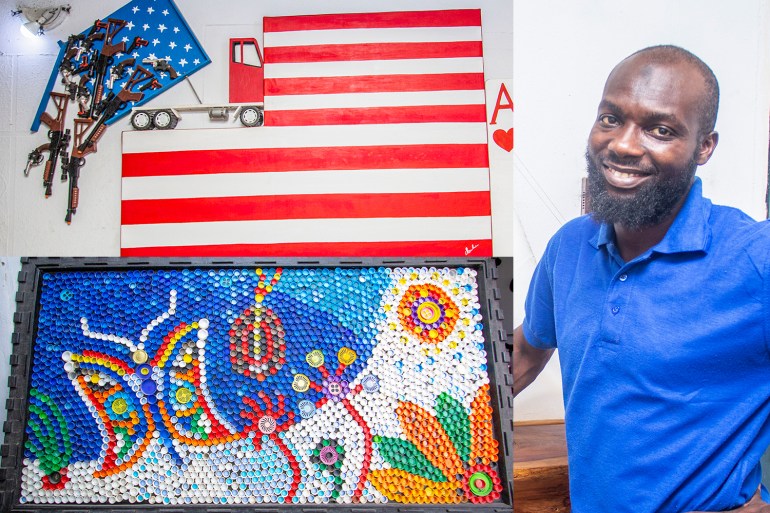
Ibrahim Gbadamosi: Using waste design to make a political statement
In 2019, while he was selling some of his artwork on the roadside around Ringroad, Ibadan, a lecturer at the University of Ibadan showed interest in Ibrahim Gbadamosi’s craft.
She invited him to present his work at the biannual conference of the Institute of Peace and Strategic Studies, being held at the university. But, when the lecturer who invited him stepped out of the venue, he was sent away by another lecturer, who threatened to call security.
Gbadamosi, 41, says his art, which is made from all sorts of different kinds of waste, often gets a mixed reception. Some love it; others hate it.
“You will find people who will close doors in your faces, and you will find people who will open doors to you.”
In his house, which doubles as a gallery, visitors will find a sailing ship made from a tree trunk; a map of Africa made from bottle tops and foam slippers; a beaded curtain made out of strings of bottle caps.
His gallery is a stone’s throw from his family home, where he grew up, in an upper-middle-class area of Ibadan. His love for art began at the age of six when he would visit a local art gallery with his sister.
Despite this early love for art, however, he says his family did not view it as a good career choice, so he studied Geology at the University of Ado-Ekiti in Ekiti State, graduating in 2003.
Gbadamosi was expected to graduate and find a good job in the oil and gas sector. But even after he did that, art remained a hobby. He spent his weekends busy, painting on canvasses, visiting galleries.
He says his family believed his love of art would remain just a hobby until his first solo exhibition in November 2011 at the African Foundation for the Arts in Lagos. His work ended up on national TV and he successfully sold some pieces from it. After that, he resigned from his job and followed the call of art completely.
His family thought he was mad to leave a good, well-paid job and refused to support him. The money he made from the exhibition soon ran out. “I could not afford paint, so I went into recycling fully. I started to make use of carpenter’s waste, bottle caps and plastic.”
Gbadamosi says whenever he went around picking up these items, people would make fun of him.
These days, in his gallery, the personal is interwoven with the political as he uses his art to make bold statements about the state of the world today. In his Politics of Violence series, he draws attention to gun violence in the US, for example. In another piece, titled About Time, a truck attached to the US flag dumps weapons.
“There would be less fatality if people who want to harm others didn’t have access to weapons at all,” he says.
With clothing materials his late mother gave him, he has made an iron table wrapped with damask cloth. With an old rubber suitcase, he has made a chair. He has given new life to old wood discarded during a renovation of his home in his London Series: a red, wooden London bus that doubles as a dining table set; a pair of Royal Guards that serve as lamps made from ice-buckets.
“I wanted to make functional art that was themed,” he says. “The common thread that runs through it is that the subjects are London icons.” London, he says, is a place his parents lived for a time and from where they would bring souvenirs for the rest of the family – it holds a significance for him in memories from childhood.
Making functional items and works of art from waste has its challenges. Bottle caps, for example, are tricky to use. “You want to do small pieces or tight-curved lines, but they are not easy to manipulate.”
The work is physically challenging as well. “When I am working with bottle tops, it doesn’t exactly sit on an easel, so I have to work with it on the floor and now I have constant back pain.”
Despite the challenges, Gbadamosi says he will continue working, as there is so much waste to work with, and so much happening in the world for his art to speak to.
“I want to always do pieces that can stand the test of time and be the best in the world.”